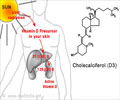Vitamin D deficiency is directly associated with a higher risk of mortality from illnesses including heart disease and diabetes.

Researchers here focused on groups from high sunlight regions that migrated to low sunlight regions between 1500 and today. The resulting population shifts caused the risk of vitamin D deficiency to rise substantially.
The researchers explored the aggregate health consequences of such migration over a long historical perspective. Researchers here constructed a measure that proxied the risk of vitamin D deficiency in a given population.
The measure tracked the difference between sunlight intensity in the ancestral place of residence of the population, as well as the actual level of sunlight intensity at the place of current residence.
Using the difference between ancestor and ambient sunlight as a measure of the potential risk of vitamin D deficiency, researchers then examined its explanatory power in relation to life expectancy around the world.
Researchers found that greater risk of vitamin D deficiency is negatively correlated with life expectancy, all else equal.
Advertisement
Advertisement
However, the lower exposure times to sunlight increases the risk of vitamin D deficiency, particularly in people with higher skin pigmentation, whose ancestors came from high sunlight regions.
Ultimately the researchers here concluded that a migration-induced imbalance between the intensity of skin pigmentation and ambient sunlight can both relate and explain present-day global health differences.
Low sunlight regions that have received substantial immigration from high sunlight regions experience lower life expectancy than would have been the case in the absence of such migration flows.
"This research is important because it is the first research to document a link between an increased risk of vitamin D deficiency and differences in life expectancy across countries and regions. It thus serves to highlight the potentially huge benefit in terms of additional life years of taking vitamin D supplements, particularly during the autumn and winter" said author Dr. Thomas Barnebeck Andersen.
Source-Eurekalert















